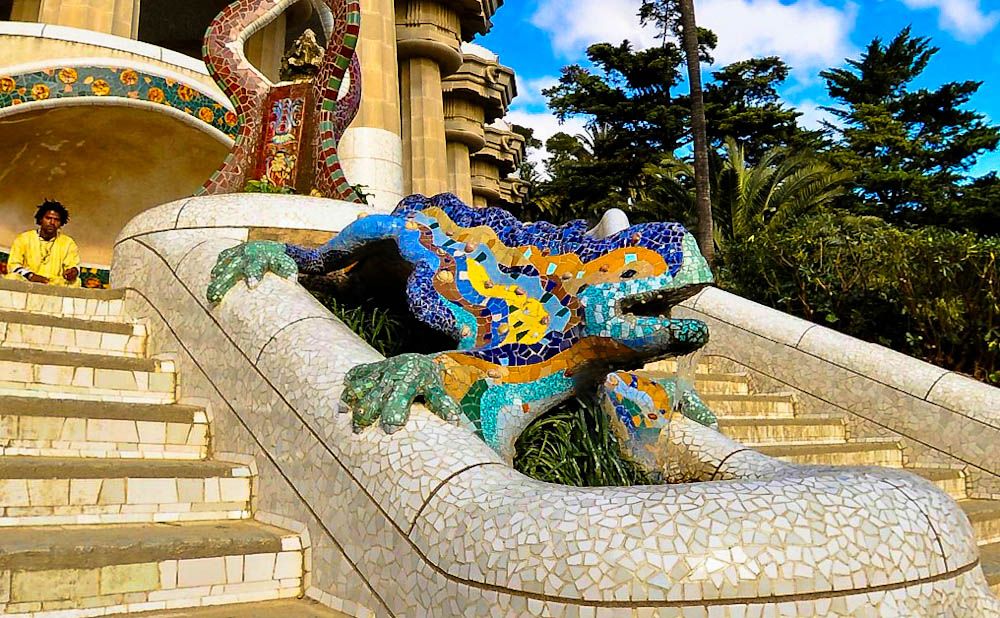Visiting Park Güell: History, Photobombs, and Gaudí’s Lizard
What do you get when you cross Alice in Wonderland with a Barcelona park? Antoni Gaudí’s psychedelic dreamland, Park Güell. Less walk in the park and more trip down the rabbit hole, visiting Park Güell has convinced many people that ‘God’s architect’ divined his inspiration from the mind-expanding properties of certain exotic fungi.
Whether that’s true or not, visiting Park Güell is enchanting, relaxing, and one of Barcelona’s essential cultural experiences. Unbound by the structural limitations of one single building, Gaudí’s artistic vision was set loose upon the side of Carmel Hill in all of its otherworldly glory, culminating in an urban green space that is quite unlike anything else.
The park provides an open-air walking tour inside the mind of a certified creative genius, which is an awesome experience, especially when it’s framed by spectacular rooftop views over the sun-kissed city he adored and very much defined.
So if you’re planning a trip to the Catalan capital, or you’re there already and squinting at this as the sun glares off your screen in the rabble of La Rambla, here’s everything you need to know about visiting Park Güell, as well as some quirky Park Güell history to make the experience all the more magical.
Skip to a section
1. Park Güell History
“Hmmm, still only one like from @realantonigaudi”
Named after its patron, Eusebi Güell, Park Güell was built between 1900 and 1914 in the quiet foothills of the Serra de Collserola mountains. It was originally intended to be an exclusive community for Barcelona’s affluent citizens, sort of a Hollywood Hills-esque escape from the smoggy bustle below, with luxurious mod cons like running water and breathable air.
So Güell hired architectural psychonaut, personal friend, and pioneer of Catalan Modernisme, Antoni Gaudí to design the private residential park. Interpreting “private residential park”, to mean “kaleidoscopic garden of earthly delights – go nuts!”, Gaudí set to work on designing a city park inspired by nature and heaven, and the results were fittingly divine.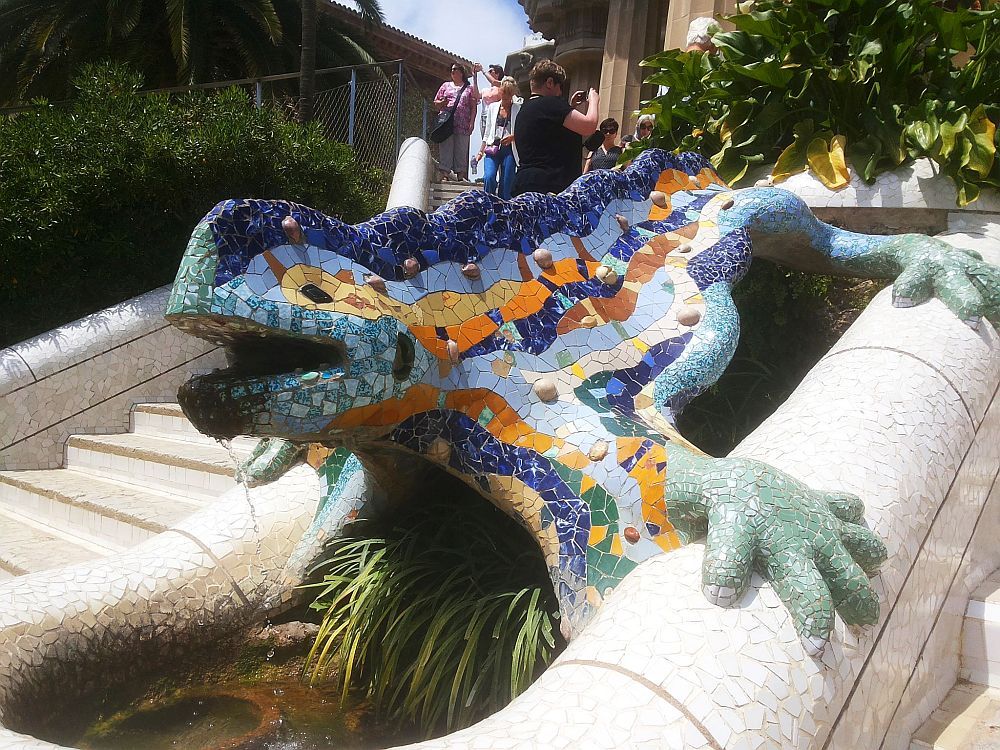
The project never gained very much traction though, with interest levels in the now-UNESCO World Heritage site hovering somewhere around whatever Catalan for “meh!” is. Of the 60 luxury villas that were planned, only two homes were ever built. Barcelona’s wealthy were apparently not ready for Gaudí – a penny for the thoughts of their grandkids now!
After consulting his trusty beard (and Güell), Gaudí decided to buy and move into one of the houses with his father in 1906, and they lived there for 20 years until the architect’s unfortunate death after a tram accident in 1926. Park Güell was opened as a public park later that year, and it’s left everyone who visits awestruck since.
2. Visiting Park Güell
How to get there:
A beautiful sunny day in Barcelona. Good thing I brought this hoodie.
Barcelona offers lots of transport options, so there are several ways to get to Park Güell. Taking the metro is possible, and there is a free shuttle bus to the gates of the park that departs from Alfons X metro station.
Regular buses will also take you within walking distance of the park, with lines 24 – 31 – 32 – H6 – 92 all operating within the vicinity. It is a steep walk up the hill though, so be prepared for some cardio if you go for this option!
By far the most convenient way to get to Park Güell is the Barcelona Hop-on Hop-off Bus. Stopping at all the city’s major attractions, this bus will take you directly to the gates of the park, and then on to wherever it is you plan on going after, while providing a breezy open-top road trip around the city along the way.
Park Güell opening times:
The park is open all year round, but the opening and closing times vary slightly throughout the year.
The park is currently open from 9:30 – 19:30.
The best time to visit Park Güell:
The best time to visit Park Güell all depends on who you are. If you’re lucky enough to live in the vicinity of the park or are a member of the Gaudir Més program, you get free entry to the park before and after its official opening and closing times.
Getting into Park Güell:
It appears the breadcrumb trail ends at this doorway…
First things first: Park Güell is big – 19 hectares big. It’s split into two zones, the unrestricted public area – comprising about 90% of the space, which is free to enter and amble around – and the monumental zone, where the vast majority of Gaudí’s fairy-tale handiwork is to be found. With so much free area to explore, some people ask if the Park Güell monumental zone is worth it? To put it mildly, the answer is yes, it is definitely worth it!
At just under €13 for an adult ticket and €9 for a child’s ticket, the monumental zone is relatively cheap for a must-see Barcelona attraction. However, the ticket queues to get inside tend to stretch as far as Madrid, and Barcelona is balmy at the best of times, so planning ahead is key.
Be smart and book your Park Güell tickets in advance to avoid slow-cooking for hours in the daytime scorch, while other smug-looking culture nerds waltz right by you, laughing with lighthearted merriment, and somehow summoning their own private air conditioning.
Tickets are time-slotted, so it’s best to arrive a few minutes early when visiting Park Guell. You have 30 minutes to enter the park from the time stated on your ticket. So, for example, if the allocated time on your ticket is 10:00, you have until 10:30 to enter the monumental zone.
Once inside, you’re free to stay as long as you like. If you want to know even more about the park as you explore, you can choose a skip-the-line ticket with a guided tour, and let an expert narrate all that fascinating Park Guell history in real-time – complete with some juicy insider knowledge! Either way, you can expect to be spoiled for all future parks. Be warned!
Tip – This is an equal-opportunities jaw-dropper, ideal for families, couples, groups of friends, and solo wanderers, but it’s not exactly stroller-friendly in some parts, and high heels are probably not a great idea either. Wear comfortable walking shoes, and bring your own water and snacks.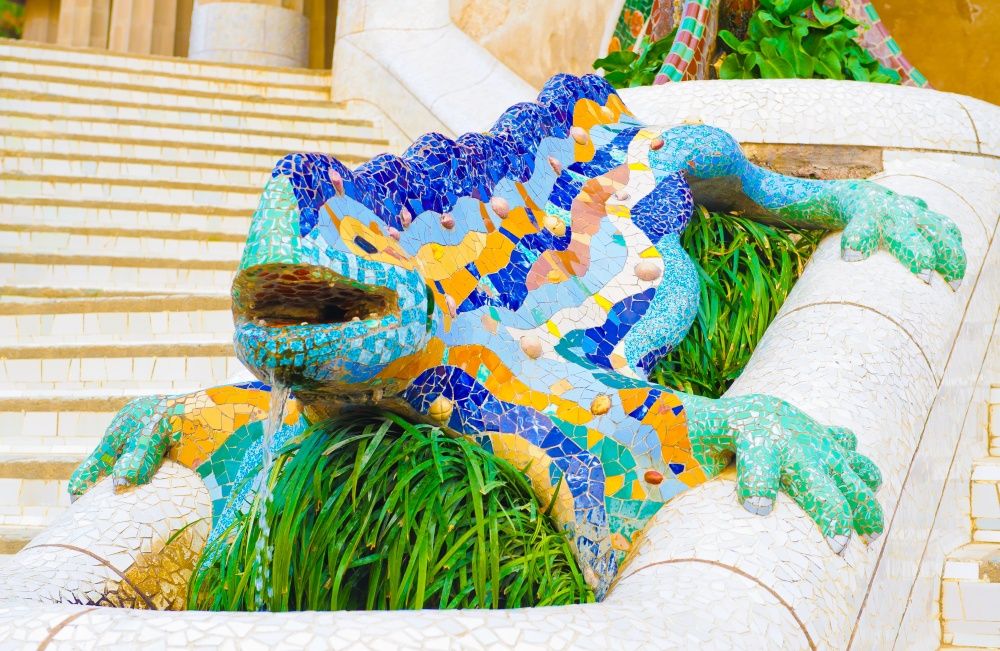
Update: To comply with local safety measures and ensure everyone can enjoy a safe experience, everyone is currently required to wear a face mask at all times when visiting Park Güell.
3.
Park Güell Highlights
The Porter’s Lodge
The first installment of enchanting architecture you’ll encounter in the real eye-candy zone monumental zone arrives in the form of two impossibly charming gate lodges. They appear to be constructed entirely out of gingerbread – complete with frosted rooftops and candy-cane spires. Classic Gaudí. The undulating curved lines are an ode to nature and a motif that features prominently throughout the park. Do not attempt to eat the houses. You will be removed.
The gate lodges are admittedly more impressive from the outside, as they now function as an information centre and a gift shop. You can take a look inside, but you will have to queue up, and you didn’t really come halfway up Carmel Hill to be cooped up indoors now did you? Onwards!
The Dragon Stairway
The Dragon Stairway
It’ll definitely have caught your eye on the way in, as it’s kind of hard to miss: the Dragon Stairway is exactly what you’d expect a stairway into wonderland to look like.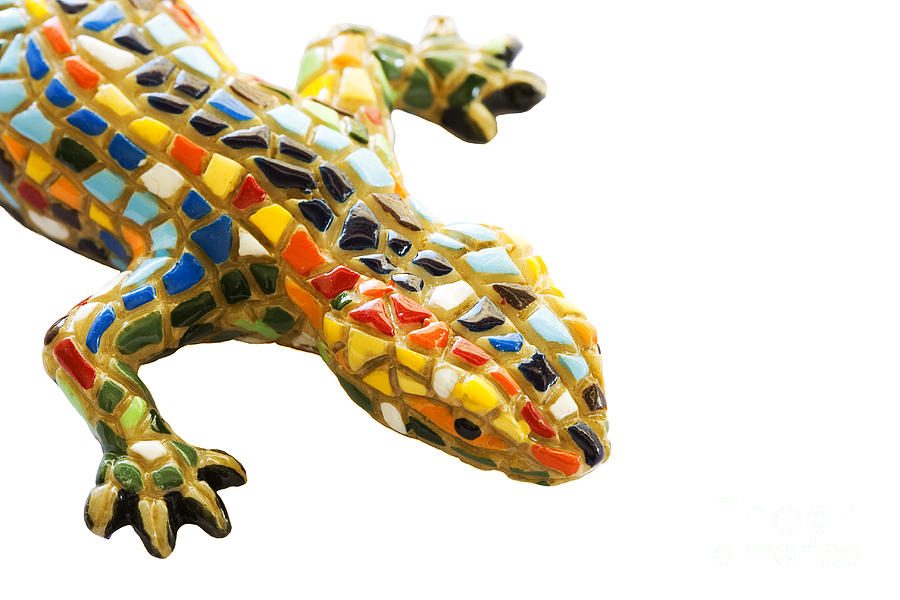
Halfway up the steps, on the first landing, there’s a small dragon fountain proudly poking out from the yellow and red emblem of Catalonia. He’s pretty cute, but it’s his big brother a few steps up that has grown into a symbol of Barcelona and a defining icon of Park Güell history, and hence tends to attract all the attention. He goes by the name of…
El Drac – the Park Güell lizard
Time to catch the dragon.
He might sound like the heavily mustachioed leader of a scary biker gang, but El Drac is, in fact, a flamboyant lizard and the friendly guardian of Park Güell. Meaning ‘the dragon’ in Catalan, El Drac’s fancy scales are fashioned out of broken shards of mosaic tiles, a style known as trencadís, which Gaudí helped to pioneer.
Gaudí’s asymmetrical arrangement of different shapes, sizes, and colors of the tiles is perhaps another nod to nature’s imperfect perfection, and you’ll see plenty of trencadís while visiting Park Güell.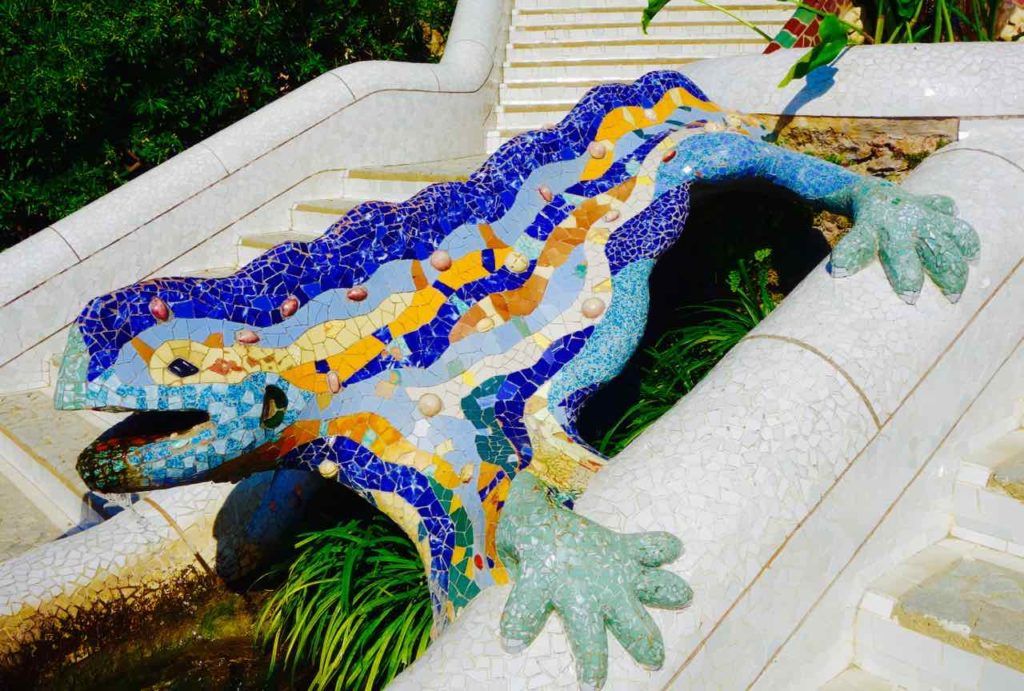
Arguably the most famous part of the park, El Drac singlehandedly keeps several dedicated Instagram servers overheating on a daily basis. At peak times, you might have to wait for the planets to align before you can snap a photobomb-free selfie. But every seasoned selfie-hunter knows that saintly patience and simmering misanthropy are all part of the fun.
The Hypostyle Room
The Hypostyle Room
After gaining an audience with the Park Güell lizard, hop to the top of the Dragon Stairway and you’re in Ancient Greece. Kind of. A big fan of Classical architecture, Gaudí designed the would-be marketplace of Park Güell with a colossal open hall supported by 86 Doric Order-style columns, called it the Hypostyle Room, and presumably enacted a strict toga-only dress code.
The ceiling of the Hypostyle Room is a pristine wave of concave domes decorated with beautiful – yep, you guessed it – mosaics.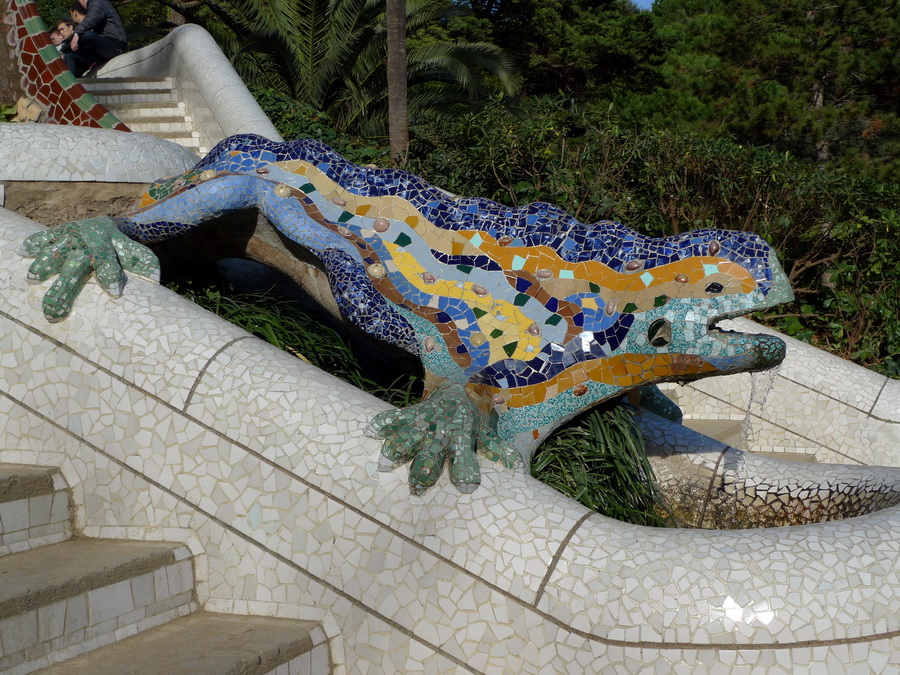
Speaking of the fluidity of nature and engineering trickery, the Doric columns were also designed as part of an ingenious water-drainage system. The system collected rainwater from the roof of the Hypostyle Room, filtered it through porous precast concrete, then channelled it down through hollows in each column and into a large reservoir. This ensured structural integrity, provided filtered water for the community, and irrigation for the park. Talk about spotting a gap in the market!
Cool, but was any potential overspill from the underground cisterns designed to shoot dramatically out of the mouth of El Drac during heavy rainfall, you ask?
Yes. Yes it was.
What engineering lizardry is this?
Plaça de la Natura
Plaça de la Natura
The Classical theme continues above the Hypostyle Room with an enormous open forum reminiscent of an Agora (central public space) of Ancient Greece.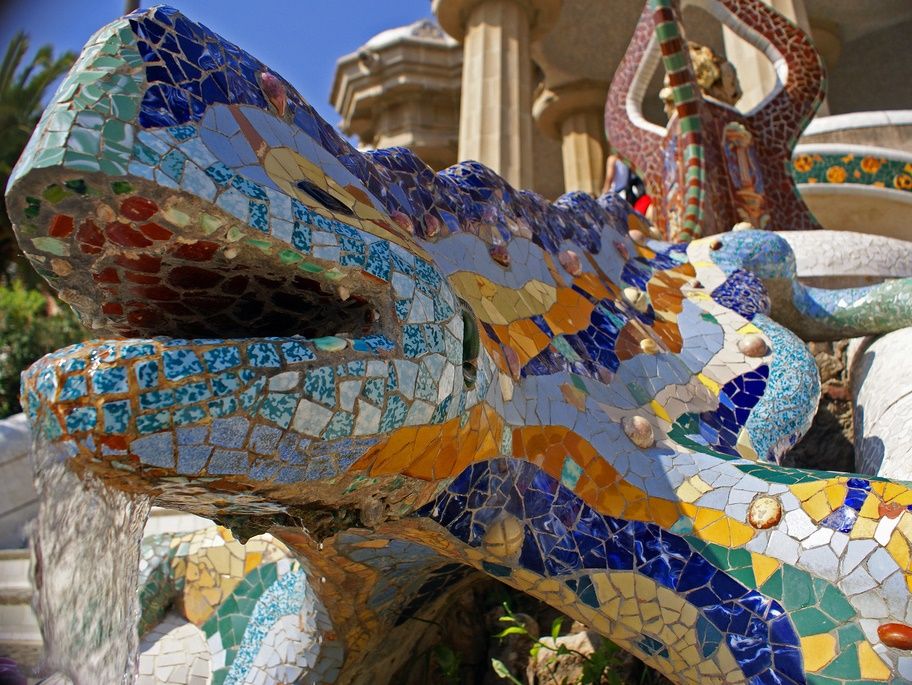
On a clear day, you’ve got swaying green palm groves on one side of the plaza, and on the other, a panoramic cityscape stretching languidly out to where the azure sky and the Mediterranean meet and melt into a fuzzy blue horizon line – all framed by a battle royale of fencing selfie-sticks! This is one of those moments everyone wants to capture. So wait for an opening in the crowd, then pounce!
While not striking your most windswept and ‘grammable poses with the coast of Catalonia, you might notice that the entire area of Plaça de la Natura is unpaved. As you are standing above the Hypostyle Room, the ground you’re walking on is designed to be porous to filter surface water, remember?
However, you might not notice this at all. Instead, your eye might be drawn to the conspicuously sidewinding rainbow bench that encircles the square like an enormous snake…
The Serpentine Bench
The Serpentine Bench
At this point in the adventure, with wanderlust levels and your ability to appreciate intricate mosaics plateauing off just a teeny bit, it’s time to chill, rest your weary bones, and take a break from all those mosaics.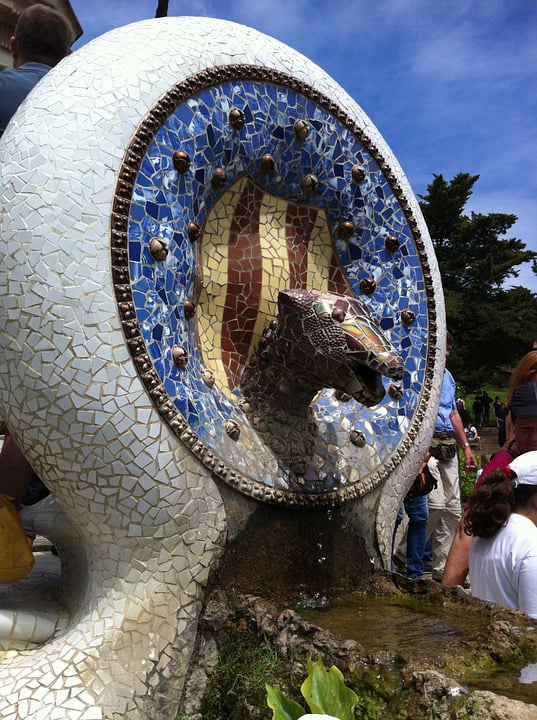
Wrong! Every inch of the spectacular Serpentine Bench is emblazoned with exquisite fragments of technicolor tiles, making it one of the park’s most iconic spots, and arguably Gaudí’s trencadís masterpiece – even if the Park Güell lizard is more famous. Just as awesome to look at as it is to sit down on, the Serpentine Bench is usually quite busy, but the sheer scale of it means you never have to wait too long to find a place to sit and inspect the artistic majesty.
The Serpentine Bench
It’s a good idea to bring your own food and bottled water while visiting Park Güell, and the Serpentine Bench makes for the perfect rest area where you can sit with a picnic, gaze out over the city, soak up some rays, and be at peace with nature. Or, taste the sweet venom of revenge, and deliberately photobomb other people’s perfect moment. Hey, they don’t call it the Serpentine Bench for nothing.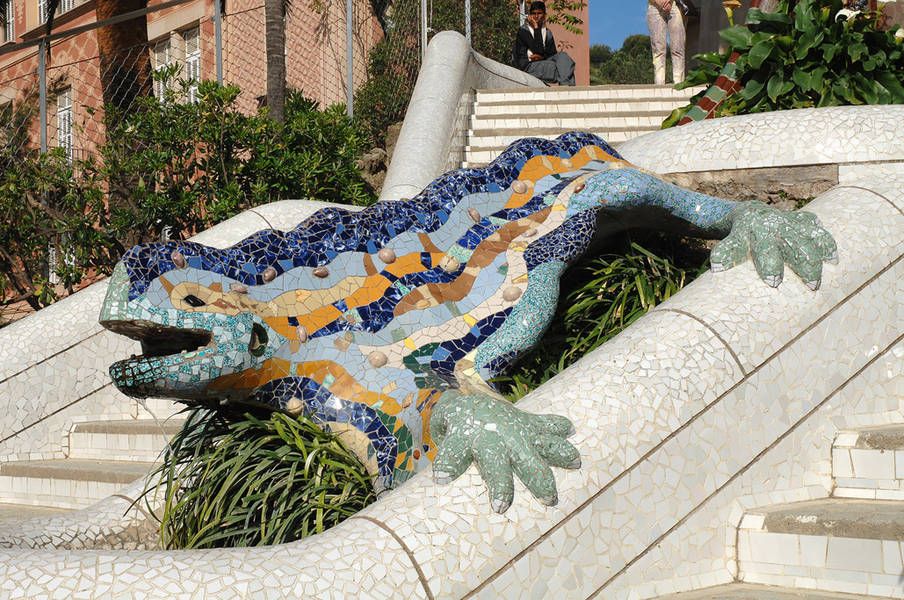
Walk this way! Park Güell’s viaducts and passages
The idea of a shared space was central to Park Güell’s foundation. However, nestled on the side of a mountain as it was, it presented Gaudí with the unique challenge of designing the space so that it felt like a community, rather than a series of disconnected villas in the hills. Mountains, after all, are famously difficult to move.
Unique challenges were Gaudí’s idea of fun though, and so he designed a winding web of walkways, bridges and viaducts to connect the higher and lower reaches of the park. He was never one to build a simple walkway where a beautiful one would do, so needless to say, these are some of the coolest parts of Park Güell. Picture gnarled, arching tree-like columns that look like they were forged by woodland elf-folk aeons ago, and you’re pretty close.
The three viaducts are called Pont de Baix, Pont del Mig, and Pont de Dalt, and each one is an engineering marvel.
The Austria Gardens
Given the zany, unconventional nature of Park Güell, perhaps the strangest part of the park is ironically its most normal. The Austria Gardens sit on the site where many of the community’s houses were intended to be built. After it was opened as a public park, this land was instead used as a plant nursery, and in 1977 many trees and plants were donated by Austria, hence the name.
Being the newest chapter of Park Güell history, the foreign flora of the Austria Gardens stands in stark contrast to the rest of the park, with northern conifers and evergreens looking decidedly non-tropical in the midst of all those sun-washed palms. Although the Austria Gardens came into being long after Gaudí’s passing, the master of quirky landscaping probably would’ve appreciated the weirdness of its conspicuous normality!
The public park – Park Güell free area
After you’ve basked in the glory of Gaudí’s sublime designs, admired the regal Park Güell lizard, and given your camera roll a decidedly mosaic-driven feel, take some time to explore some of the public areas of Park Güell.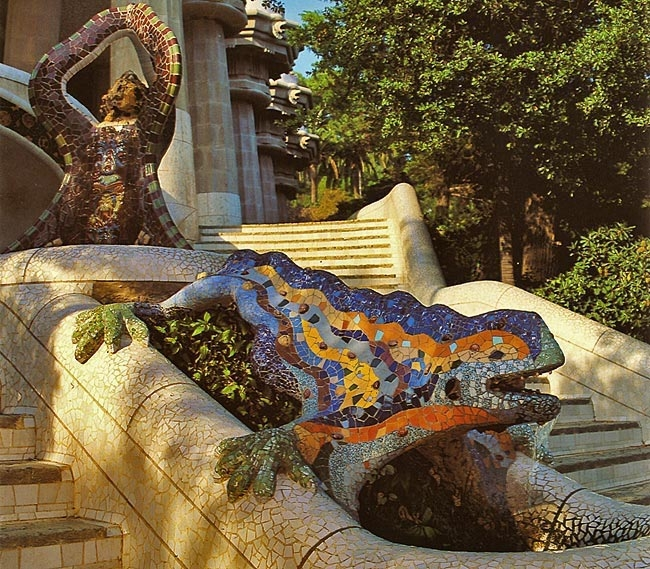
4.
What to Add to Your Barcelona Itinerary
Park Güell is definitely one of Barcelona’s essential cultural attractions. But there is so much more spellbinding architecture to see in the city. If the park piqued your interest in the fantastical buildings of Antoni Gaudí, you absolutely cannot leave the city without seeing his pièce de résistance, the mind-blowing Sagrada Familia.
“One of the most hideous buildings in the world” – George Orwell.
Widely considered Gaudí’s masterpiece, construction on this huge basilica began in 1882 and is scheduled to finish in 2026, one hundred years after his death. Every square foot of this towering temple is decorated with intricate spiritual and naturalistic art.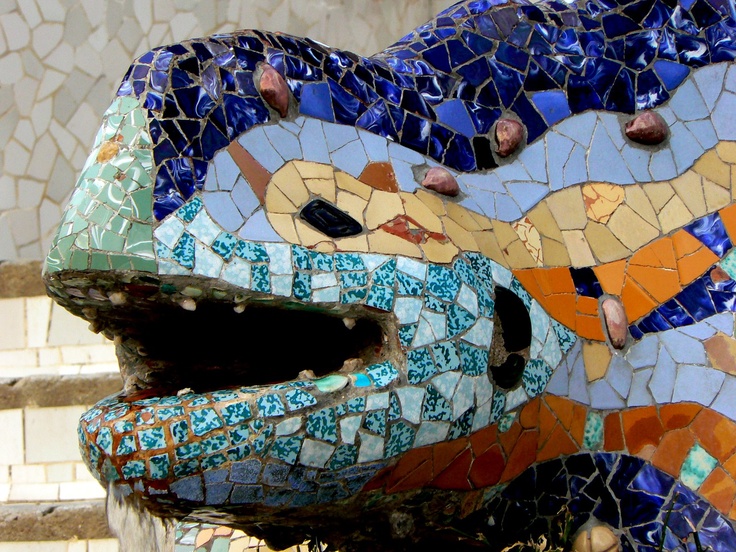
Ok, it’s definitely kicking in now!
For something slightly less bombastic, but equally quirky and quintessentially Gaudí, stop by some of his imaginative city residences, like Casa Batlló, Casa Milà (La Pedrera), or the first house he ever designed, Casa Vicens. Each one of these incredible dwellings is unique, but each also displays Gaudí’s limitless imagination and playful creativity.
If you’re all Gaudí’d out after visiting Park Güell there are plenty of other magical activities and attractions around Barcelona to keep you double-taking, from amazing art museums and galleries to world-class aquariums and zoos, cable-car rides high over the city, the home of one of the world’s best football teams, tours to the jaw-dropping natural splendor of Montserrat, flamenco shows, and plenty of pretty districts to wander around, chill on a terrace with tapas and a cold drink. Salutacions!
Make sure you book your Park Güell tickets in advance, to discover this playground of dazzling architecture during your stay in Barcelona.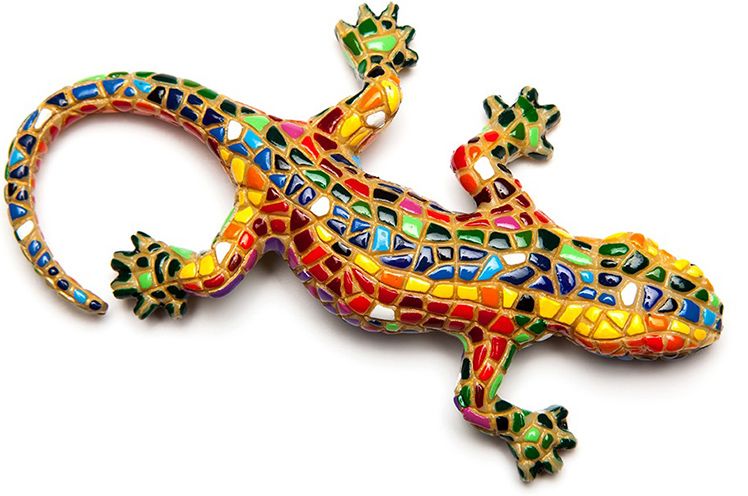
Tags: BarcelonaCulture
Park Güell – Gaudi’s Extraordinary Park
Home / About Barcelona / Park Güell – Gaudi’s Extraordinary Park
in About Barcelona
May 19, 2021
0
2,001 Views
Out of all the projects taken on by ANTONI GAUDÍ, no other encapsulates the complete and perfect harmony of nature and architecture than Park Güell. Eusebi GÜELL commissioned Park Güell. He sought to create a stylish and lavish park for the aristocrats of Barcelona. The park contains stunning stone structures, spectacularly detailed tiling and fascinating buildings, eventually becoming Barcelona’s most unusual public park.
The architect chose an uneven site covering a surface area of 15 hectares. The original project included the construction of 60 detached houses.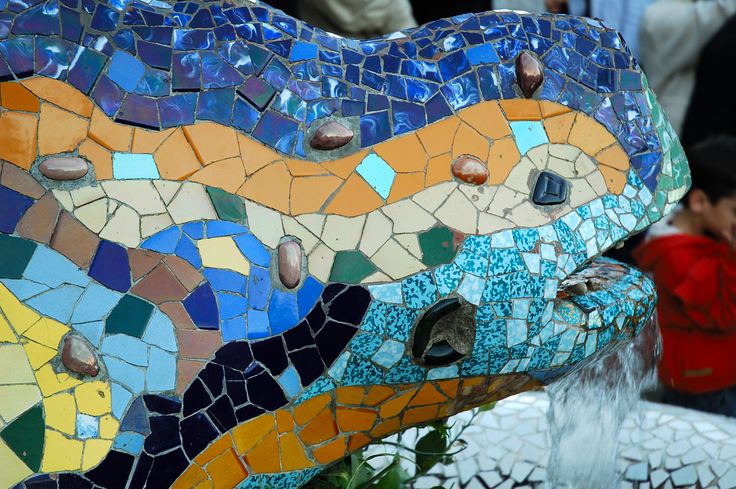
The Park
While passing through the entrance of Park Güell, the remarkable dragon fountain without fail captivates the attention of passers-by. This dragon is bejewelled in beautiful coloured tiling and there is something rather mesmerising and enchanting about it. There is a beautiful walkway supported by twisting rock pillars that appear to be growing out of the ground like tree trunks. Although these pillars are somewhat peculiar in shape, they somehow also feel strangely natural.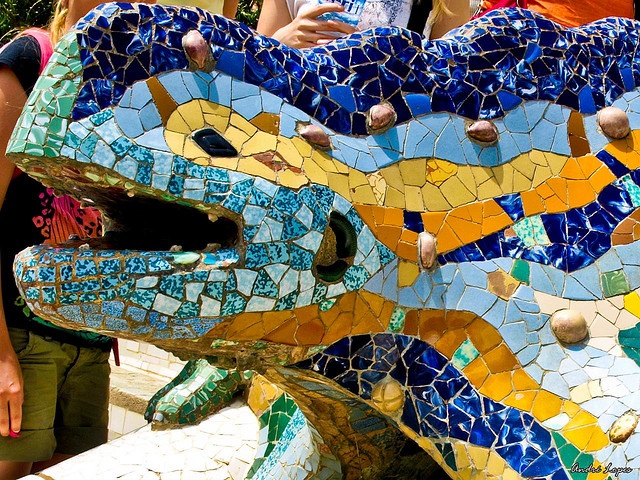
If you reach the top of Park Güell, there is a blissful terraced area overlooking the city. In there, you can get a sublime view of the park and of course Barcelona City. Here you will find an explosion of color with the beautiful tiled mosaic seats. Their vibrant colours are truly breath-taking. Park Güell also has a small house in the park, which is where Gaudí lived at one point. The house has now been converted into a museum and contains interesting furniture and artifacts which were also designed by Gaudí.
The pavilions and the most known symbol of the Park
In Park Güell there are two houses as well as pavilions for visitors and park keepers. The Hansel and Gretel story inspired Gaudí for the pavilions’ design: radiant coloured tiles and ornamented spires cover the curved roofs. The staircase at the entrance of the park is a magnificent sight.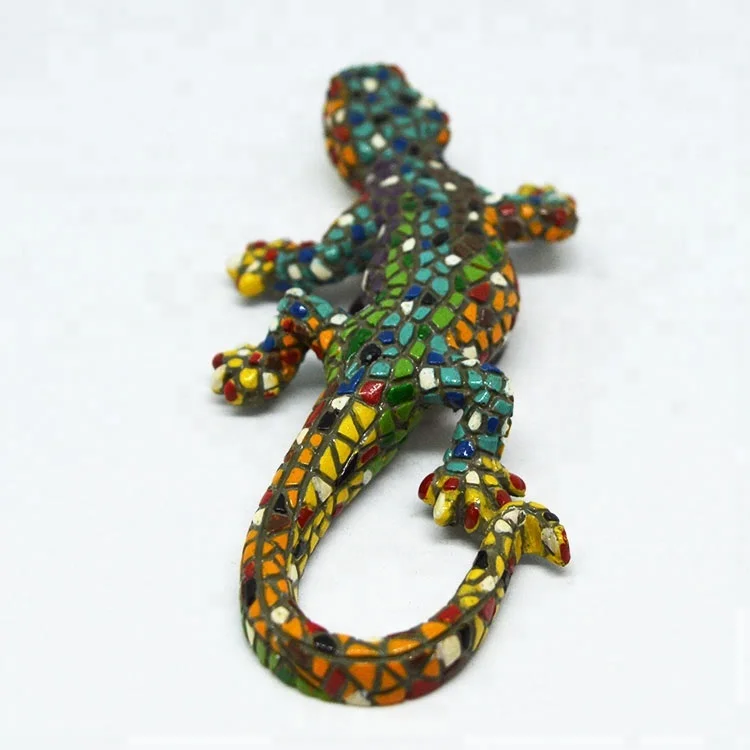
Tickets and Prices
Park Güell is located in the district of GRÀCIA. You have to pay to access the monumental area of the park where all the buildings are. We recommend to book a ticket online in advance to be sure you can enter the park. The number of visitors per day is, in fact, limited. However, you can also walk freely in other parts of the park. Remember that it is free the visit on the first Sunday of every month.
PRICES: For kids from 0-6 years old is free, for kids from 7 to 12 is €7 and the general ticket is €10
Ver esta publicación en Instagram
Una publicación compartida por Park Güell Oficial (@parkguell)
Information
TRANSPORT: By Metro – Vallcarca or Lesseps stations (Green Line, L3) On leaving the metro follow the street signposts for the park | Bus – 24 and 92.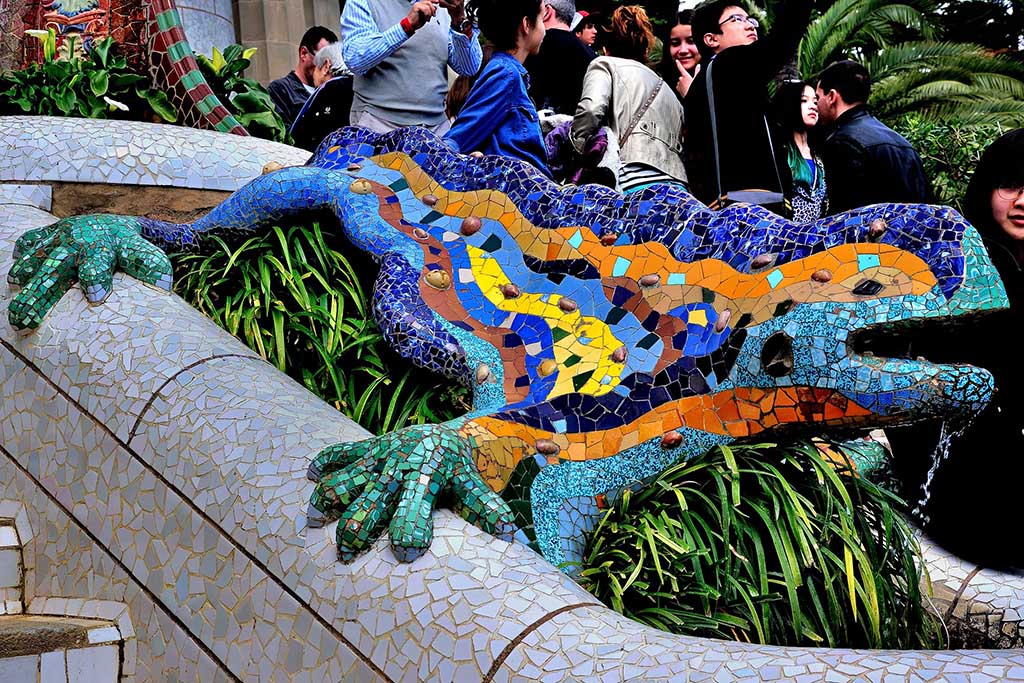
OPENING HOURS: Everyday 9:30-19:30
ADDRESS: Carrer d’Olot 5, 08024, Barcelona
Are you planning a trip to Barcelona and looking for somewhere to stay? Why not take a look at the available apartment rentals on our website! Please feel free to contact us with any questions you may have.
2021-05-19
- tweet
-
Previous: The Best Terraces in Barcelona
Next: Carrer del Parlament: a visit to food paradise
Written by: Barcelona-Home
Hello there! We hope you are enjoying our website full of interesting blogs to read. We absolutely love Barcelona and we hope that when you come to visit you will too!
Gaudí’s lizard – a symbol of Barcelona
In the Park Güell there is an impressive Gaudi’s mosaic lizard, which has become a true symbol of Barcelona.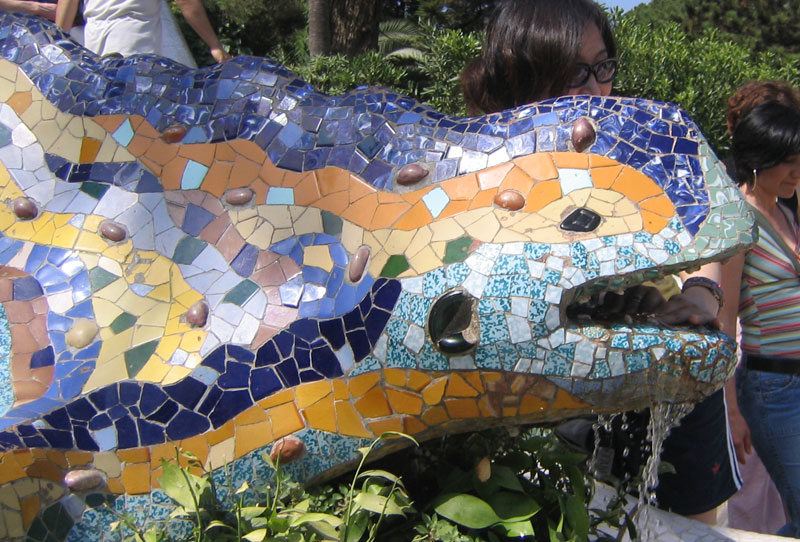
Gaudí’s lizard in Parc Güell
Antonio Gaudí’s lizard, 2 m long and 40 cm long, is the centerpiece of the fountain. The latter is located on the main staircase of the park – the Dragon Stairs. The reptile perched on an oval-shaped bowl. With her paws, she holds on to the edges of the bowl, and water flows from the ajar mouth.
Don’t forget to buy your tickets in advance to skip the lines. You can do this using the link .
Gaudí’s lizard and trencadis technique
Broken ceramic elements were used to finish and decorate the sculptures, including the famous lizard.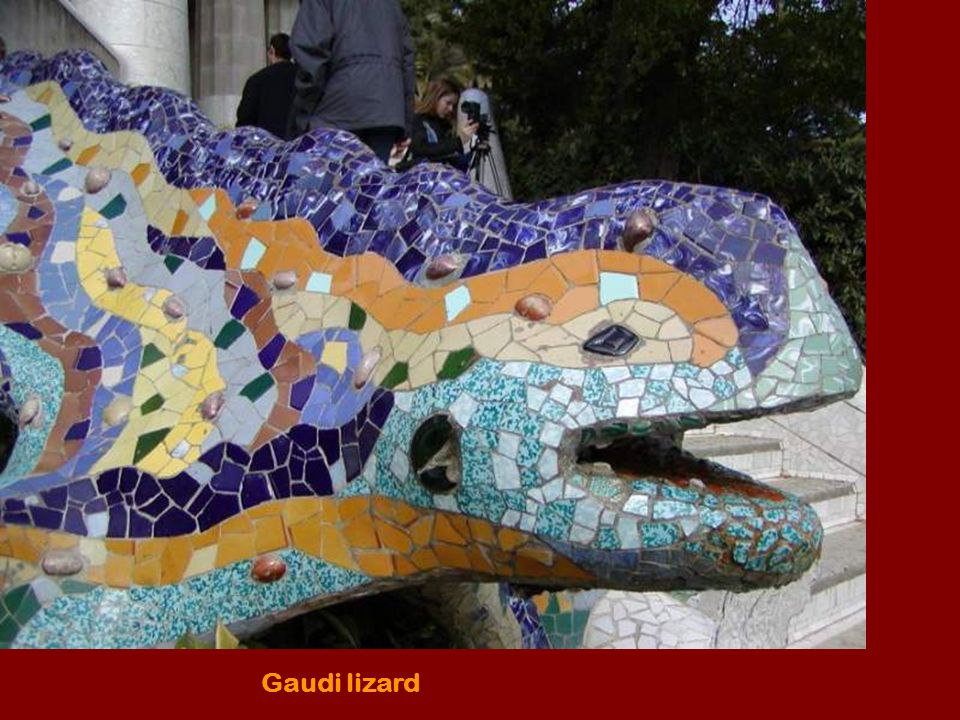
“Trencadis”
“Trencadis” (Trencadis) – a technique for creating compositions from improvised materials.
After the opening of the park, many began to consider Antoni Gaudí the inventor of this technique. In fact, the architect and his best student, Josep Maria Jujol, only helped develop the trendcadis technique.
Even the ancient Romans knew the mosaic technique opus tessellatum, then the fragments were used mainly to hide irregularities. In the 19th century, in the territory of Catalonia, in painting and architecture, they began to master the new technique of “trencadis” under the influence of a peculiar neo-mudejar style.
In America, trendcadis is known as crazy paving, and in France as pique assiette.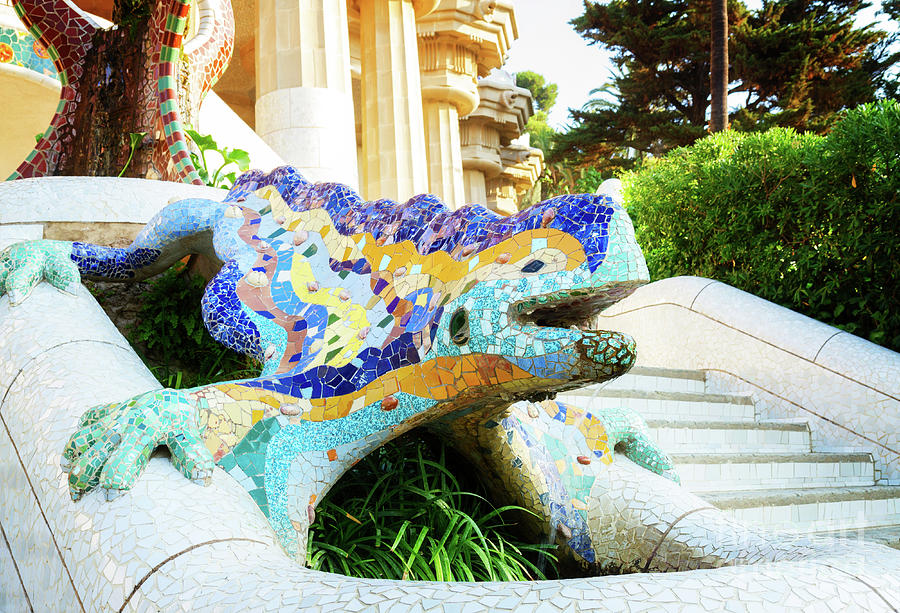
Parc Güell, Trencadis
Genuine works of art by Antoni Gaudí
In addition to the lizard, Gaudí and Jujol decorated with mosaics:
- the ceiling of the “Hall of 100 Columns”
- large sea serpent bench
- Sagrada Familia
- houses Casa Batllo and Casa Mila
Casa Batllo
Antonio Gaudi respected nature, so he was very inspired by the idea of creating original creations from rubbish, which under other circumstances would have migrated to the city’s landfills.
Don’t forget to buy your tickets for Gaudí attractions in advance. You can do this online using the link on the official ticket platform.
Serpent, salamander or crocodile
In 1969, a copy of the mosaic lizard took pride of place among the exhibits of the Madrid Museum of Modern Art. But since the architect did not give her a name, the researchers could not decide which of the mythical creatures the lizard embodied.
Various versions put forward:
Crocodile on the coat of arms of the city of Nimes
- The serpent Python is an evil and dangerous creature from ancient Greek mythology. He guarded the passage to the Delphic oracle and was killed by Apollo. Above is a tripod, which may indicate that the monster was destroyed by the golden-haired god of Light.
And in the center of the sculpture is a stone, as if symbolizing the “navel of the Earth” in Delphi. These elements support the snake theory.
- The alchemical salamander is undoubtedly a symbol of the element of Fire. Medieval legends speak of the amazing abilities of a cold-blooded creature, able, thanks to its low body temperature, not only to survive in fire, but also to extinguish the flame, no matter how strong it may be.
- Crocodile, which was depicted on the coat of arms of the city of Nîmes. In this French town, a friend of Antonio Gaudi and the former owner of the park, the Catalan industrialist and philanthropist Eusebi Güell i Basigalupi, spent his youth.
The lizard is not the first reptile the architect has created. The first salamander was designed by Antonio Gaudí before he became famous, and became part of the decoration of the Cascada Fountain, which he worked on with Josep Fonsere.
Gaudí’s Lizard in Ciutadella Park
The Parc Güell lizard looks more like its predecessor than an evil snake or a French crocodile.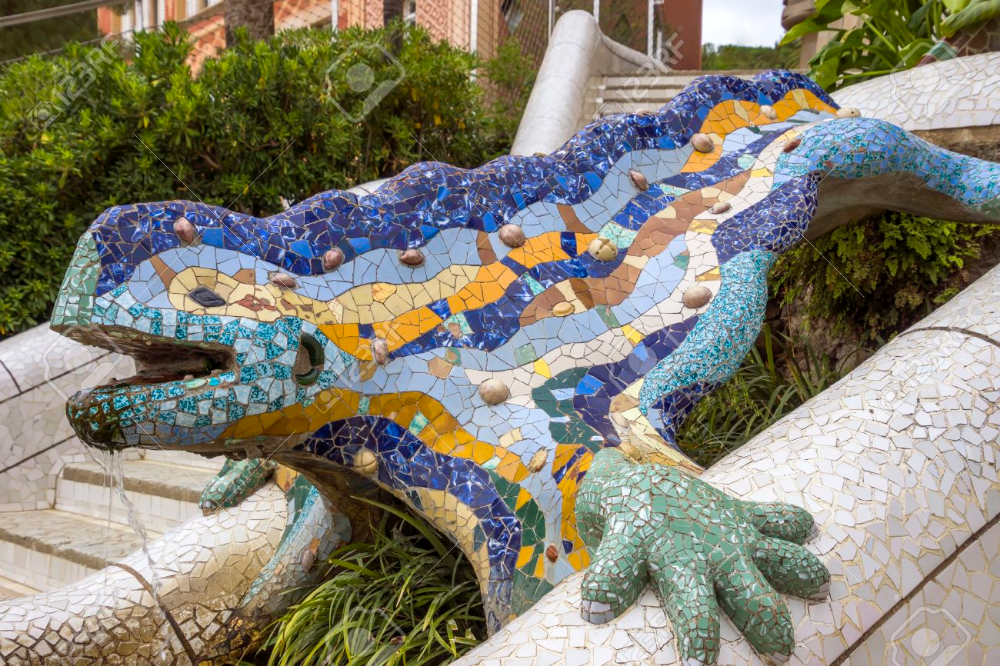
How to get there
Barcelona has an excellent transport interchange, so you can get to Park Güell using public transport:
- buses nos. H6, D40, V19 and 116
- by metro: lines 3 and 4 (L3 and L4)
- on suburban trains Nos. L7, S1 and S2
The Dragon Staircase, on which Antonio Gaudí’s lizard is located, is undeniably hard to miss and not notice. By the way, it is located right in front of the main gate of the park.
- How to avoid queues at Barcelona attractions. Tickets for the Sagrada Familia and Park Güell skip the line.
-
How not to be deceived by local taxi drivers.
Order a taxi in advance with fixed rates online. The most reliable service for ordering a taxi is KiwiTaxi .
- Excursions in Barcelona with locals will help you to get to know this city for real. The best way to get comfortable in an unfamiliar city is to walk around it with a person who has lived here for many years.
- We advise you to take out travel insurance so that there are no unpleasant surprises while traveling to Barcelona.
- Barcelona City Pass is a one-stop card that makes organizing your holiday in Barcelona easier and saves a lot of time and money.
- Barcelona Hotels: is our selection and recommendations.
- Bus Turistic is a tourist bus and a great way to get to all the necessary monuments of Barcelona quickly, with a breeze and comfort.
-
Drimsim is a universal international SIM card and a free travel application.
Best prices, fast internet and worldwide calls.
Why is Antoni Gaudí’s lizard from Parc Güell the symbol of Barcelona?
|
Main -> Eternal Questions 03/26/2015 According to ancient Greek legend, the beautiful city of Barcelona was founded by the legendary mythical hero Heracles. When, as part of a flotilla of nine ships, he went in search of the Golden Fleece, his ship was captured by a storm and carried to an unknown land. It was the shore of the Mediterranean Sea at the foot of Montjuic. Climbing the mountain, Hercules was struck by the beauty of the area spread before his eyes. He decided to found a city there and give it a name in honor of the ship on which he sailed to this wonderful country – “Barka Nona”. In memory of this event, another outstanding hero of his time, the brilliant architect Antonio Gaudí, who lived in Barcelona at the turn of the 19th and 20th centuries, decided to perpetuate the glorious name of Hercules in his creations. Gaudí’s genius was manifested in the ability to combine architecture and nature into a single whole. He managed to interweave one into the other in some incomprehensible way. Incompatible architecture, ancient Greek myths, astronomy, botany and poetry are combined in this magnificent creation. To the right of the entrance to the park, a sculptural composition of several orange trees is crowned with a branch with golden fruits, symbolizing golden magical apples. And the territory of the park is planted with willow and poplar, in which the gods, in a fit of anger, turned the unfortunate Hesperides. But the main focus of the park was another character of the legend – the mythical dragon Ladon, who guarded the apples and died at the hands of Hercules. It is this dragon that is symbolized by a huge, mosaic-decorated lizard that greets visitors at the entrance to the park. According to the architect’s idea, anyone who comes to the Garden of the Hesperides, be it the legendary Hercules or a tourist of the 21st century, before crossing the threshold of the park, will encounter a ferocious amphibious dragon vigilantly guarding the magical fruits. The unique lizard, created by the hand of the master, fell in love with the inhabitants of Barcelona so much that a belief arose from their light hand, picked up by tourists from all over the world. If you touch a lizard in Park Güell, you will definitely come back to sunny and hospitable Barcelona. A huge number of visitors strive to see the legendary lizard and imprint on its background. She became the most recognizable symbol of the first park, and eventually the city itself. |

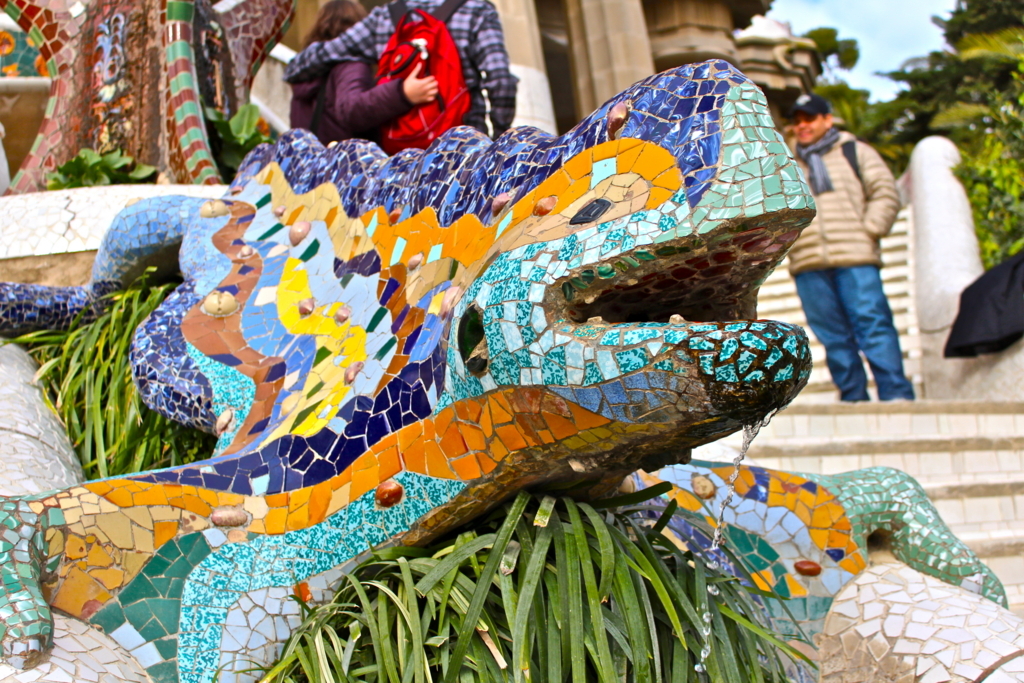 And in the center of the sculpture is a stone, as if symbolizing the “navel of the Earth” in Delphi. These elements support the snake theory.
And in the center of the sculpture is a stone, as if symbolizing the “navel of the Earth” in Delphi. These elements support the snake theory. 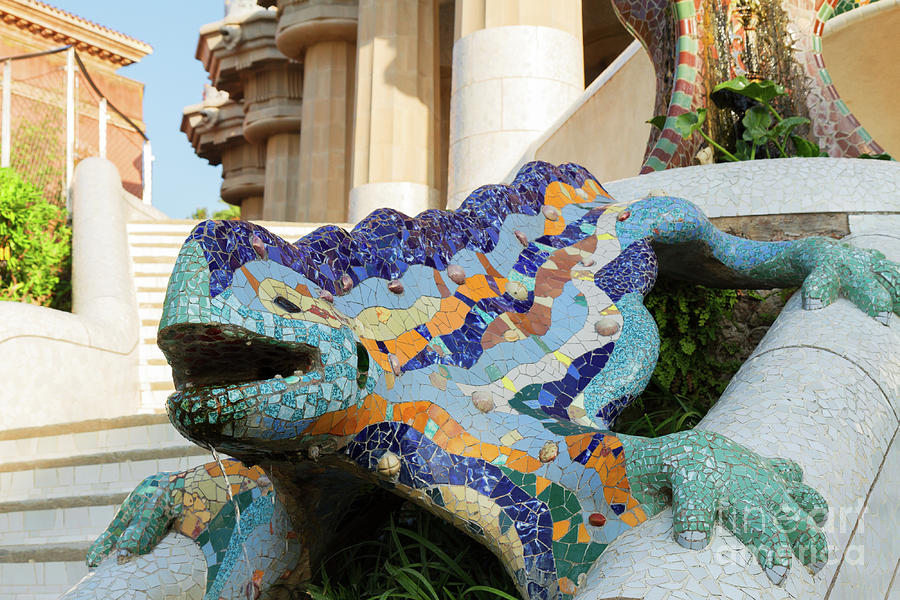 Order a taxi in advance with fixed rates online. The most reliable service for ordering a taxi is KiwiTaxi .
Order a taxi in advance with fixed rates online. The most reliable service for ordering a taxi is KiwiTaxi .
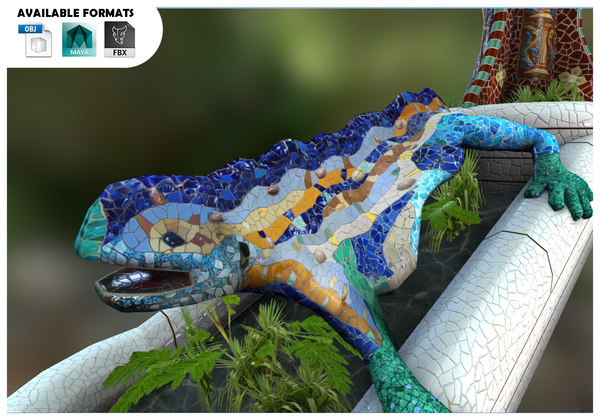 Best prices, fast internet and worldwide calls.
Best prices, fast internet and worldwide calls.
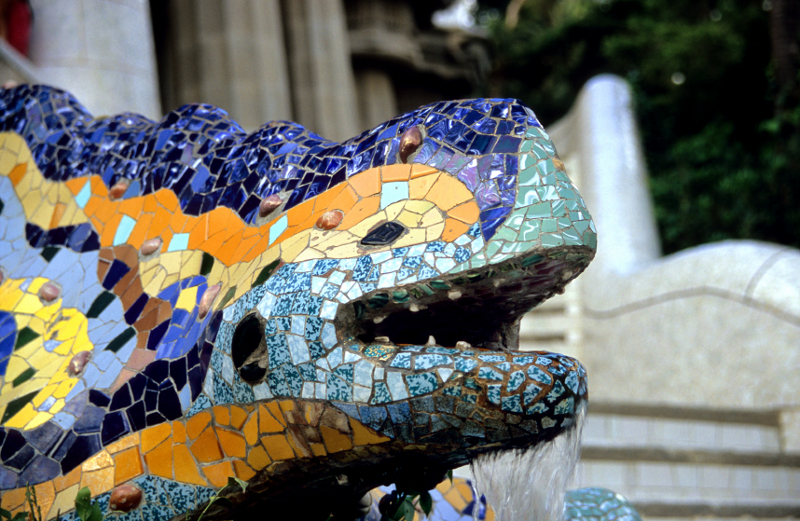 Inspired by the eleventh feat of the hero, Gaudi decided to recreate the divine garden of the Hesperides with its magical rejuvenating apples. Through the efforts of the architect, in the deserted, waterless and sparsely populated place of Montaña Pelada, which means Bald Mountain, the amazingly beautiful Park Güell with magnificent fountains, fantastic buildings and unique viewing platforms is spread.
Inspired by the eleventh feat of the hero, Gaudi decided to recreate the divine garden of the Hesperides with its magical rejuvenating apples. Through the efforts of the architect, in the deserted, waterless and sparsely populated place of Montaña Pelada, which means Bald Mountain, the amazingly beautiful Park Güell with magnificent fountains, fantastic buildings and unique viewing platforms is spread. 